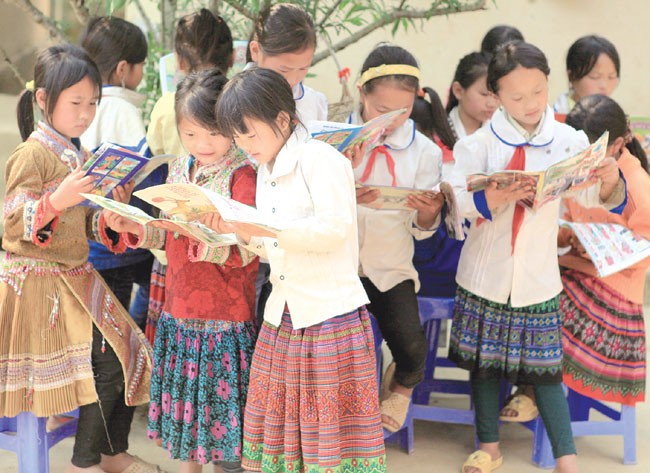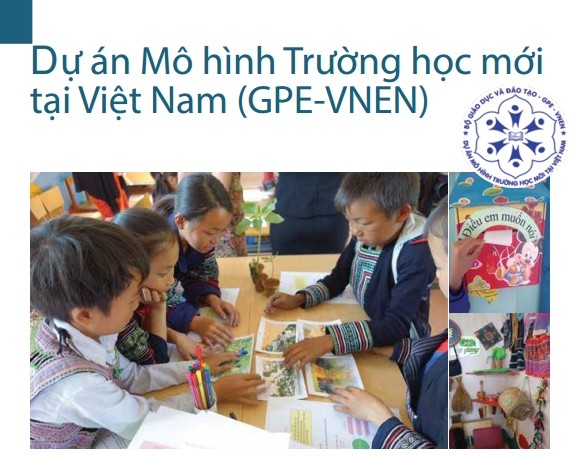(VOVworld) – Schools across Vietnam will hold the opening ceremony for the 2016-2017 academic year on 5 September. The education sector, both in Hanoi and in provinces affected by recent torrential rains, flooding, and drought have overcome all sorts of difficulties and are ready for an effective new school year.
 |
| Ethnic minority students of the Man Than Primary School in Lao Cai prepare for the new school year. (Photo: Thai Ha/ VNS) |
Torrential downpours and flashfloods recently hit the northern province of Lào Cai, causing great losses for local schools.
To provide the necessary conditions for teaching and learning in the new school year, Lào Cai authorities have stepped up repair works.
Primary School No 1 of Quang Kim Commune in Bát Xát District is one of the schools hardest hit. When the flood ebbed, it left the school’s entire campus and all its first-floor classrooms were covered with a thick layer of mud; the foundation was seriously depressed; thousands of library books and teaching equipment were ruined. But the repairs have now been completed.
Apart from Quang Kim Primary School in Bát Xát District, six other schools also suffered serious damage.
But to begin a new academic year as scheduled, Bát Xát district has mobilized all its resources and received support from young volunteers, teachers, and educational staff from different localities under a mutual support movement.
Đỗ Mai Thông, Deputy Head of the district’s Education and Training Section, said: “Although Typhoon Nida had caused great losses, we promise to do our best, especially with the support of the community, to begin the new school year as planned. It will take place on time and with acceptable infrastructure.”
Ninh Thuận is one of the provinces stricken by prolonged draught, its Thuận Nam District being the epicenter of the natural disaster. It has suffered a great deal of economic damage, making the local people’s living extremely hard and putting children in danger of dropping out of school.
Nguyễn Quang, Deputy Head of the district’s Education and Training Section, said Ninh Thuận would have about 130,000 students this academic year – 10,000 of them in the drought-hit district of Thuận Nam.
Quang added the district’s education and training section had coordinated with other agencies at all levels to provide disadvantaged children with textbooks and bikes so that they can attend school.
In this way, Quang said, the local authorities hope to minimize school drop-out rates. In the 2016-2017 academic year, the education and training sector will continue urgent reforms in teaching and learning methods. The biggest changes will continue to be focused on the primary level. Hanoi’s education and training sector will conduct evaluation for primary pupils through online teacher-parent books so as to reduce pressure on teachers.
 |
| The Ministry of Education and Training has encouraged schools across the country to voluntarily continue applying the new model of learning and teaching, called the Việt Nam Escuela Nueva (VNEN). (Photo: thcsluongkhanhthien.phuly.edu.vn) |
Hanoi will also continue to apply a new model of learning and teaching, called the Vietnam Escuela Nueva (VNEN), at primary and secondary schools.
Phạm Xuân Tiến, Deputy Director of the capital’s Education and Training Department, said the model was designed to make students more engaged in class with teachers serving as facilitators, and parents as well as other community members more involved in making learning relevant to children.
“We’ll implement the program step by step. First we’ll focus on communications with schools and parents, calling on them to support the model but without forcing students to join the program. If schools find it applicable, they can register. To make the model a success, teachers should change their way of thinking,” said Tiến.
To date, most districts and wards in Hanoi have completed fundamental preparations for teaching, learning, and training, with teachers ready to serve more than 1.7 million students at all levels.
The 2016-2017 academic year is the third year the sector has conducted the government’s action plan on fundamental renovation of the educational system, under which the Ministry has set out nine priority missions for the future.
They include stepping up the vocational direction for students; improving the quality of teaching and learning of foreign languages; and boosting the application of IT to teaching, learning, and education management.